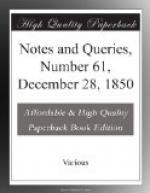NOTES.
Illustrations of Scottish ballads.
In the ballad of “Annan Water” (Border Minstrelsy, vol. iii.) is the following verse:—
“O he has pour’d
aff his dapperpy coat,
The silver
buttons glanced bonny;
The waistcoat bursted
aff his breast,
He was sae
full of melancholy.”
A very unexpected effect of sorrow, but one that does not seem to be unprecedented. “A plague of sighing and grief,” says Falstaff. “It blows a man up like a bladder.”
A remarkable illustration of Falstaff’s assertion, and of the Scottish ballad, is to be found in this Saga of Egil Skallagrimson. Bodvar, the son of Egil, was wrecked on the coast of Iceland. His body was thrown up by the waves near Einarsness, where Egil found it, and buried it in the tomb of his father Skallagrim. The Saga continues thus:—
“After that, Egil rode home to Borgar; and when he came there, he went straightway into the locked chamber where he was wont to sleep; and there he laid him down, and shot forth the bolt. No man dared speak a word to him. And thus it is said that Egil was clad when he laid Bodvar in the tomb. His hose were bound fast about his legs, and he had on a red linen kirtle, narrow above, and tied with strings at the sides. And men say that his body swelled so greatly that his kirtle burst from off him, and so did his hose.”—P. 602.
It is well known that the subjects of many ballads are common to Scotland, and to the countries of Northern Europe. Thus, the fine old “Douglas Tragedy,” the scene of which is pointed out at Blackhouse Tower, on the Yarrow, is equally localised in Denmark:
“Seven large stones,” says Sir Walter, “erected upon the neighbouring heights of Blackhouse, are shown as marking the spot where the seven brethren were slain; and the Douglas Burn is avowed to have been the stream at which the lovers stopped to drink; so minute is tradition in ascertaining, the scene of a tragical tale, which, considering, the rude state of former times, had probably foundation in some real event.”
The corresponding Danish ballad, however, that of “Ribolt and Guldborg,” which has been translated by Mr. Jamieson, is not less minute in pointing out the scene of action. The origin of ballads, which are thus widely spread, must probably be sought in very high antiquity; and we cannot wonder if we find them undergoing considerable {506} change in the passage from one country to another. At least the “Douglas Tragedy” betrays one very singular mark of having lost something of the original.
In “Ribolt and Guldborg,” when the lady’s brothers have all but overtaken the fugitives, the knight addresses her thus:
“Light down, Guldborg,
my lady dear,
And hald our steeds
lay the renyes here.
And e’en sae be
that ye see me fa’
Be sure that ye never
upon me ca’;
And e’en sae be
that ye see me bleed,
Be sure that ye name
na’ me till dead.”




